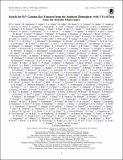Search for PeV Gamma-Ray Emission from the Southern Hemisphere with 5 Yr of Data from the IceCube Observatory
Author(s)
Arguelles Delgado, Carlos A; Axani, Spencer Nicholas; Collin, G. H.; Conrad, Janet Marie; Diaz, Alejandro; Moulai, Marjon H.; ... Show more Show less
DownloadPublished version (2.084Mb)
Publisher Policy
Publisher Policy
Article is made available in accordance with the publisher's policy and may be subject to US copyright law. Please refer to the publisher's site for terms of use.
Terms of use
Metadata
Show full item recordAbstract
© 2020. The American Astronomical Society. All rights reserved. The measurement of diffuse PeV gamma-ray emission from the Galactic plane would provide information about the energy spectrum and propagation of Galactic cosmic rays, and the detection of a pointlike source of PeV gamma-rays would be strong evidence for a Galactic source capable of accelerating cosmic rays up to at least a few PeV. This paper presents several unbinned maximum-likelihood searches for PeV gamma-rays in the Southern Hemisphere using 5 yr of data from the IceTop air shower surface detector and the in-ice array of the IceCube Observatory. The combination of both detectors takes advantage of the low muon content and deep shower maximum of gamma-ray air showers and provides excellent sensitivity to gamma-rays between ∼0.6 and 100 PeV. Our measurements of pointlike and diffuse Galactic emission of PeV gamma-rays are consistent with the background, so we constrain the angle-integrated diffuse gamma-ray flux from the Galactic plane at 2 PeV to 2.61 × 10-19 cm-2 s-1 TeV-1 at 90% confidence, assuming an E -3 spectrum, and we estimate 90% upper limits on pointlike emission at 2 PeV between 10-21 and 10-20 cm-2 s-1 TeV-1 for an E -2 spectrum, depending on decl. Furthermore, we exclude unbroken power-law emission up to 2 PeV for several TeV gamma-ray sources observed by the High Energy Spectroscopic System and calculate upper limits on the energy cutoffs of these sources at 90% confidence. We also find no PeV gamma-rays correlated with neutrinos from IceCube's high-energy starting event sample. These are currently the strongest constraints on PeV gamma-ray emission.
Date issued
2020-02Department
Massachusetts Institute of Technology. Department of PhysicsJournal
Astrophysical Journal
Publisher
American Astronomical Society